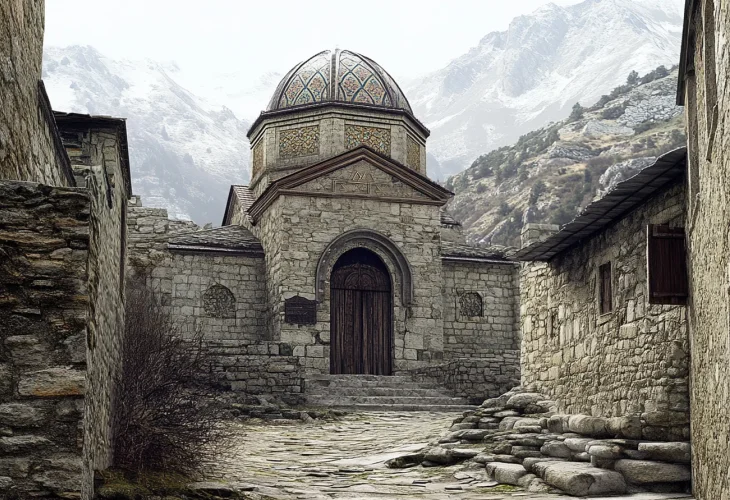History and Archaeology
2,500 Years of Tradition: The Unique World of the Mountain Jews
Discover the rich history, unique customs, and miraculous survival of the Mountain Jews, a community rooted in the days of Ezra the Scribe

The Beit Tanchum synagogue in Tirat Carmel is more than just a place of prayer it’s also a site of wonder. Its design, inspired by the ancient Beit HaMikdash (Holy Temple), includes courtyards, domes, and mosaics. While many may not be familiar with it, even fewer know the incredible history of the community that built it, a history that traces back over 2,500 years, to the time of Ezra the Scribe.
Back then, after the Persian king Cyrus allowed the rebuilding of the Temple in Jerusalem, Ezra called on Jews across the Persian Empire to return to the Land of Israel. During his journey, he camped by the “Ahava” river for three days and took a count. He realized there were no Levites, essential for the Temple service.
Ezra remembered a nearby Jewish community called Cushfaya, likely made up of descendants of Levites from the original exile. He sent a message to their leader, Ido, asking him to send Levites to help. As described in the Book of Ezra (Chapter 8), Ido responded generously, sending twenty Levites and two hundred and twenty servants, woodcutters and water carriers, for the service of the Beit HaMikdash.
But the rest of Cushfaya’s Jews stayed where they were. They supported Ezra’s mission, but didn’t believe it would succeed enough to return themselves.
That place Cushfaya, or in Persian, Caspiana is near today’s Caspian Sea in modern-day Azerbaijan. Since Ezra’s time, Jews have lived in that region. Their community grew especially during the time of the Jewish Khazar kingdom. King Bulan, one of its rulers, established a strong Jewish presence in the fortified city of Derbent. There, Purim is celebrated on the 15th of Adar, because tradition holds the city had a wall during the time of Mordechai and Esther.
Over the centuries, most of the Jews in the Caucasus Mountains came to be known as the Mountain Jews. In Russian, they’re called Gorskie Yevrei. During times of persecution especially under the Sassanian Empire many Jews fled to the mountains to protect their traditions, and the name stuck.
Under Soviet rule, Mountain Jews were pressured to abandon their religious life. A law required them to add a “B” to their last names. Many still carry names with that letter today. But none of this stopped their devotion. Against all odds, they preserved their customs and Torah observance for thousands of years.
During the Holocaust, many Mountain Jews were killed, but a miracle occurred when the Nazis reached towns like Mozdok and Nalchik. A German commander was unsure if Mountain Jews were considered part of the extermination order. He detained thousands in labor camps but delayed deciding their fate. Before he could act, the Red Army arrived and drove the Nazis out. Thanks to this delay, most of the Mountain Jewish community especially in Derbent was saved.
In the years that followed, many Mountain Jews made Aliyah and settled in cities like Tirat Carmel, while others remained in the mountains, continuing their way of life.
Even today, their traditions are unique and inspiring. Chabad Rabbi Schneur Segal, serving in Azerbaijan, once tried to help them prepare properly for Pesach (Passover). He ordered a shipment of kosher-for-Passover goods, including sugar. But when an elderly Mountain Jewish woman saw sugar at the Chabad house, she was shocked. “Sugar during Nissanu?!” she exclaimed, using their local name for the month of Nissan. Their community had long avoided sugar during Passover out of fear it might contain chametz (leavened ingredients). Even after Rabbi Segal showed her the kashrut certification from Badatz Yerushalayim, she questioned whether he was truly a rabbi!
On Seder night, they eat a special dish called Kisani Boruchoi, made from thorns. This is based on a Midrash that says Egyptian children threw thorns into the clay baths where Jewish slaves worked barefoot.
Another custom: their Seder plate does not include a shank bone. But on the morning of the Seder, they cook one, and every firstborn in the family eats from it, recalling the plague of the firstborn in Egypt.
One prominent Mountain Jewish family is the Adam family, which includes General Yekutiel Adam, who fell in the First Lebanon War; his son Udi Adam, a commander in the Second Lebanon War; and the popular Israeli singer Omer Adam.
Like Jewish communities all over the world, the Jews of the Caucasus held onto their identity with deep love and fierce strength. Many have moved to Israel, where they continue to honor and preserve their ancient customs just as their ancestors did when Ezra the Scribe first reached out, so many centuries ago.

